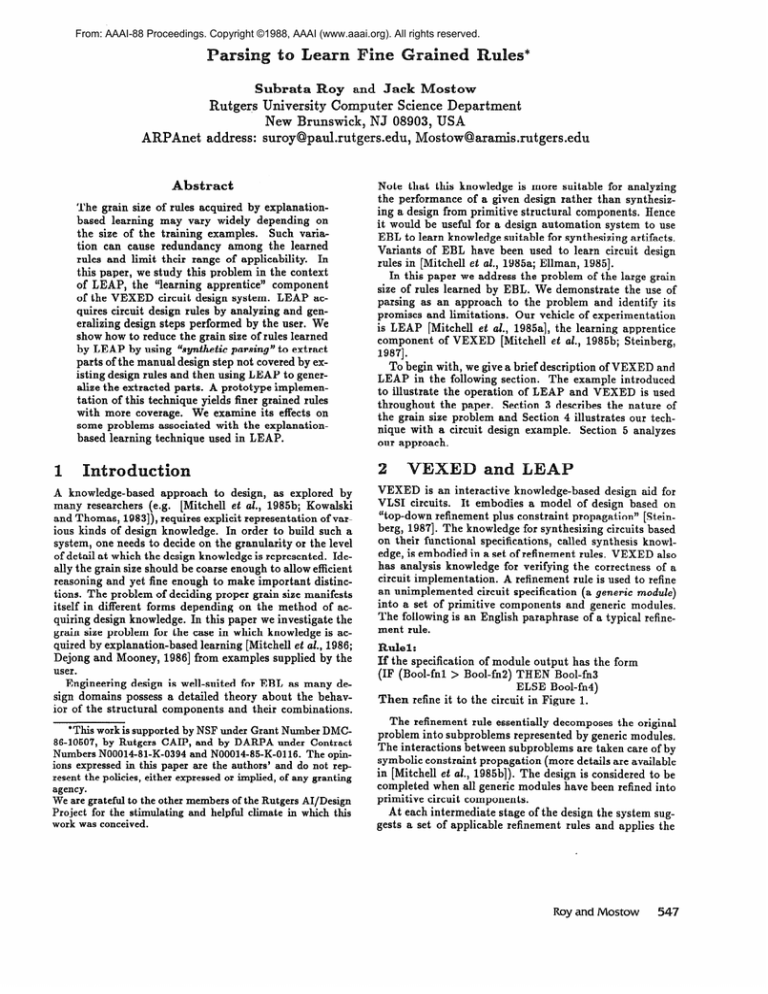
From: AAAI-88 Proceedings. Copyright ©1988, AAAI (www.aaai.org). All rights reserved.
ostow
Subratx3
oy and Jack
University Computer Science Department
New Brunswick, NJ 08903, USA
address: suroy@paul.rutgers.edu,
Mostow@aramis.rutgers.edu
Rutgers
ARPAnet
Abstract
The grain size of rules acquired by explanationbased learning
may vary widely depending
on
the size of the training examples.
Such variation can cause redundancy
among the learned
rules and limit their range of applicability.
In
this paper, we study this problem in the context
of LEAP,
the “learning apprentice”
component
of the VEXED
circuit design system.
LEAP acquires circuit design rules by analyzing and generalizing design steps performed by the user. We
show how to reduce the grain size of rules learned
by LEAP by using “synthetic parhzg” to extract
parts of the manual design step not covered by existing design rules and then using LEAP to generalize the extracted
parts. A prototype implementation of this technique yields finer grained rules
with more coverage.
We examine its effects on
some problems associated
with the explanationbased learning technique used in LEAP.
‘II
A knowledge-based
approach
to design, as explored by
many researchers
(e.g.
[Mitchell et al., 1985b; Kowalski
and Thomas, 1983]), requires explicit representation
ofvarious kinds of design knowledge.
In order to build such a
system, one needs to decide on the granularity
or the level
of detail at which the design knowledge is represented.
Ideally the grain size should be coarse enough to allow efficient
reasoning and yet fine enough to make important
distinetions. The problem of deciding proper grain size manifests
itself in different forms depending
on the method of acquiring design knowledge. In this paper we investigate the
grain size problem for the case in which knowledge is acquired by explanation-based
learning [Mitchell et al., 1986;
Dejong and Mooney, 19861 from examples supplied by the
user.
Engineering
design is well-suited for EBL as many design domains possess a detailed theory about the behavior of the structural
components
and their combinations.
*This work is supported by NSF under Grant Number DMC86-10507, by Rutgers CAIP, and by DARPA under Contract
Numbers N00014-81-K-0394 and N00014-85-K-0116. The opinions expressed in this paper are the authors’ and do not represent the policies, either expressed or implied, of any granting
agency.
We are grateful to the other members of the Rutgers AI/Design
Project for the stimulating and helpful climate in which this
work was conceived.
Note that this knowledge is more suitable for analyzing
the performance
of a given design rather than synthesizing a design from primitive structural
components.
Mence
it would be useful for a design automation
system to use
EBL to learn knowledge suitable for synthesizing artifacts.
Variants of EBL have been used to learn circuit design
rules in [Mitchell et arl., 1985a; Ellman, 19851.
In this paper we address the problem of the large grain
size of rules learned by EBL. We demonstrate
the use of
parsing as an approach
to the problem and identify its
promises and limitations.
Our vehicle of experimentation
is LEAP
[Mitchell et csl., 1985a], the learning apprentice
component
of VEXED
[Mitchell et cal., 1985b; Steinberg,
19871.
To begin with, we give a brief description of VEXED
and
LEAP in the following section.
The example introduced
to illustrate
the operation
of LEAP and VEXED
is used
throughout
the paper.
Section 3 describes the nature of
the grain size problem and Section 4 illustrates
our technique with a circuit design example.
Section 5 analyzes
our approach.
LEA
VEXED
is an interactive
knowledge-based
design aid for
VLSI circuits.
It embodies a model of design based on
“top-down refinement plus constraint
propagation”
[Steinberg, 19871. The knowledge for synthesizing circuits based
on their functional
specifications,
called synthesis knowledge, is embodied in a set of refinement rules. VEXED
also
has analysis knowledge for verifying the correctness
of a
circuit implementation.
A refinement rule is used to refine
an unimplemented
circuit specification
(a generic module)
into a set of primitive components
and generic modules.
The following is an English paraphrase
of a typical refinement rule.
RuleI:
If the specification
of module output has the form
(IF (Bool-fnl
> Bool-fn2) THEN Bool-fn3
ELSE Bool-fn4)
Then refine it to the circuit in Figure 1.
The refinement rule essentially decomposes
the original
problem into subproblems
represented by generic modules.
The interactions
between subproblems
are taken care of by
symbolic constraint propagation
(more details are available
in [Mitchell et arl., 1985b]). The design is considered to be
completed when all generic modules have been refined into
primitive circuit components.
At each intermediate
stage of the design the system suggests a set of applicable refinement rules and applies the
.
Roy and Mostow
547
Composed
Specificatim
(or
(AND Bool-fnl
(NOT
Bool-fn3)
(not
(AND Bool-fnl
(and
(and
:
Bool-fn2))
This box
(AND KeyI
This Box implements
(AND Bool-fnl
(NOT (Bool-fn2))
I
I
Bool-frill
*
i
I
IL-I-------------------~
implements
(NOT Key2))
I
I
Bool-fn2
,
:
I
I
Figure
2: A manual
refinement
Identifiers of4he form Bool-fnl represent any boolean function.
Figure 1: Result
of a refinement
rule
one chosen by the user. The user may alternatively
choose
to refine the circuit by hand. In this case LEAP, the learning apprentice component
of VEXED, generalizes the manual refinement
step into a new refinement
rule.
LEAP
uses a variant of explanation-based
learning (called ver$cation based learning [Mitchell et al., 1985a]). The example
manual refinement is “explained” by constructing
a proof
for the correctness
of the circuit using analysis knowledge.
The proof is then generalized to construct
a general refinement rule which adds to the synthesis knowledge.
To illustrate,
consider
the task of implementing
a
modified 2-to-1 multiplexer
controlled
by the condition
(Key1 >
Key2).
Key1 and Key2 are l-bit binary values. Hence (Key1 > Key2) is equivalent to (AND Key1
(NOT Key%)). D e p en d’in g on the value of (Key1 > Key 2)
either (Port1
OR Port2)
or (Port1
AND Port2)
is connected to the output.
Hence the output specification
for
the multiplexer
is
Specl:
IF (Key1
The proof in Figure 4(A) is then generalized by abstracting away details not tested by the preconditions
of the rule.
The generalized proof tree is shown in Figure 4(B). The
learned rule extracted
from the generalized proof is Rulel,
presented earlier as an example of a refinement rule. Next
time a similar circuit is being designed, VEXED
would
suggest this newly learned rule.
Learning
and KnowledgeAcquisition
(AND Bool-fnl (NOT (Bool-fn2)))
(Bool-frill
> Bool-fn2)
B2:
PBE =
(OR (ILNDBool-fnl Bool-fn2)
(AND (NOT Bool-fnl) Bool-fn3) )
(IF Bool-frillTHEN Bool-fn2
ELSE Bool-fn3)
POST =
Figure
(or
(and
(and
> Key%) THEN (Port1 OR Port2)
ELSE (Port1 AND Port2)
Suppose the user chooses to manually refine the module
into the circuit in Figure 2.
LEAP
explains the manual refinement
in Figure 2 by
proving that the composed
specification
constructed
by
“symbolically executing” the circuit on its inputs is equivalent to the desired specification
Specl.
The proof (Figure
4(A)) uses the rules of equivalence of boolean expressions
in Figure 3. These rules are expressed as rewrite rules in
which the precondition
expression
can be replaced by the
postcondition expression.
548
RI.:
PRE =
POST =
(and
3: Verification
Key1
(not Key2))
(or
(Port1
or PortP))
(not
(and Key1
(not
Key2)))
(Port1
and Port2))
)
(and
(and
rules
(and
Bool-fnl
(not Bool-fn2))
Boo1 -fn3)
(not
(and Bool-fnl
Bool-fn4)(not
Bool-fn2)))
RI
\1
(or
(and
(and
(or
(and
(and
\1
RI
(or
(Key1 > Key2)
(Port1
or Port2))
(not (and Key1
(not Ke 2)))
(Port1 and Port27)
(and
(Bool-fnl
Bool-fn3)
(not (and
> Bool-fn2)
Bool-fnl
(not Bool-fn2))
RI
RI
(Key1 > Key2)
(or
(Port1
or Port2)
(not (Key1 > Key2))
(Port1
and Port2)))
(If
(Key1
> key2)
Then (Port1
or Port2)
Else
(Port1
and Port2)
(and
(and
(and
(Bool-fnl
> Bool-fn2)
Bool-fn3)
(not (Bool-fnl
> Bool-fn2))
Bool-fnq)
)
(If
)
PROOF
(A)
(Bool-fnI.>
Then Boo1 -f n3
Else Bool-fn4)
GENERALfZFD
Bool-fn2)
PROOF
The rules apply to the boldfaced parts of the expression.
Figure
4: Proofs
constructed
by LEAP
>
3
Grain
size problem
in LEAP
Canposed
The learning architecture
of LEAP causes a problem which
limits the usefulness of learned rules in VEXED.
This has
been identified as the grain size problem in [Mitchell et
al., 1985a].
LEAP always learns a single refinement
rule
from a manual refinement.
However, the learned rule may
actually be composed
of several finer grained rules.
For
example, Rule1
can be considered to be composed of
Rule2:
of the module output has the form
If the specification
(IF Bool-fnl THEN Bool-fn2
ELSE Bool-fn3)
Then refine it to the circuit in figure 5.
and
Rule3:
If the specification
of the module output has the form
(Bool-fnl
> Bool-fn2)
Then refine it to the circuit in box B2 in Figure 1.
A refinement rule em r is considered to be of larger grain
size than another refinement
rule E, if we can construct
a tree of rules i! containing
E such that application
of t
produces the same result as a single application
of P. For
example,
de2 followed by BuIe3
will produce the same
result as a single application
of
ulel.
Hence
de1 is of
larger grain size than both Rule2
and BPnPe3. Due to the
varying size of the manual refinements,
the rules learned
by LEAP will be of varying grain size. This leads to the
following problems limiting the usefulness of the learned
rules in VEXED,
the performance
system.
Less coverage:
Firstly, a large grained rule is not
applicable in many situations,
even though it contains
all the relevant information.
For example, consider the
specification:
Spec2:
IF (Key1
= Key%) THEN (Port1 OR Port2)
ELSE (Port1 AND Port2)
(or
Bool-fnl
eduudaney:
Rules of varying grain size often overlap. For example Rule2
can be considered
to be a
part of Rulel.
If rules are redundant then more rules
must be acquired to achieve the same coverage.
Efficieucy:
If the rules used by the performance
system are too fine grained then a large number of rules
need to be applied to complete a design.
For interactive systems like VEXED,
this means that the user
has to make too many choices.
etic
arsin
The first two effects of the grain size problem as identified
in the previous section suggest that the rules should ‘be
Specification
:
(Bool-fnl)
Bool-fn2)
(not
(Bool-fnl))
M2
i
Figure
5: THEN
part
as fine grained as possible.
gests use of larger grained
can be resolved by splitting
two phases.
of a refinement
rule
However the last effect sugrules.
This apparent
conflict
the rule learning process into
In Phase 1 we try to learn as much as possible from
the single training example, i.e. learn rules which apply
in more cases and produce a larger range of designs when
used along with other existing rules. Hence in this phase
the system should try to learn as fine grained a rule as
possible. We propose the technique of “synthetic pursing”
to extract fine grained rules from the manual refinement.
In Phase 2 the objective
is to increase the efficiency
of the performance
system.
In interactive
systems like
VEXED
this means that the user has to make fewer control
decisions.
So we need to reorganize
the rules to produce
rules of larger grain size. This may be done by forming
macro-steps
by composing finer grained rules [Huhns and
Acosta,
19871 or by storing design plans and “replaying”
[Mostow and Barley, 19871 them when necessary.
Our current
Pkulel does not apply to Spec2,
even though it is
almost the same as Specl
and could be implemented
simply by changing the components
in box B2 in Figure 2. Secondly, larger grained rules may not be able
to produce alternative
designs. Alternative
implementations of the specification
(BooI-fnl
> Bool-fn2)
will not get used if Rule1
is the only rule available
for refining Specl.
(and
(and
work implements
a prototype
for Phase
1.
If a manual refinement step corresponds
to a large step,
one way to extract a fine grained rule from it is to determine which parts of the step can be accounted
for by the
existing rules. The part that cannot be accounted
for by
any existing rule is isolated and generalized into a new rule
using LEAP.
Parsing a manual refinement is the process of finding a
hierarchy
of refinement rules which when applied to the
initial module will decompose
it into the same circuit as
the manual refinement.
The hierarchy
of existing rules
found is called a pwse tree. If the hierarchy of rules is
allowed to contain newly synthesized
rules, then the process is called synthetic parsing and the hierarchy of rules
is called a synthetic parse tree.
We assume the user chooses to refine a module manually only if none of the applicable rules refines it toward
the desired circuit.
Thus the parse tree for the module
will require a new rule at the top.
So we use a simple
bottom-up
parser which iteratively
replaces a connected
set of modules (Ml...Mn)
by a single module (M), if there
is a refinement rule which refines M to the group of connected modules Ml...Mn.
Given this scheme of parsing,
the following questions need to be answered to modify it
Roy and Mostow
549
(or
(and
(and
PORT1 and PORT
(If
Bool-fnl
Bool-fn2)
(not Bool-fnl)
Bool-fn3)
)
R2
\1
Bool-fnl
Then
Bool-fn2
Else Bool-fn3)
GENERALIZED
PROOF
(B>
PROOF
w
Figure
to implement
6: Proof
synthetic
5
Parsing
can be viewed as explanation
[Vanlehn,
19871.
Parsing allows synthesis knowledge (the refinement rules)
to explain part of the manual refinement and leaves the
rest to be verified by LEAP using its analysis knowledge.
Hence learned refinement rules can contribute
to explanation of future manual refinements when synthetic parsing
is added to LEAP. Parsing also affects some problems related to EBL [Mitchell et cal., 1985a] in LEAP.
Intractability
of verification:
Comparison
of the
proof (Figure 4) for the complete refinement step and
that (Figure 6) of New-rule1
extracted
by the synthetic parser shows that the latter is much smaller.
Hence fine grained rules appear to be less expensive
However this may be offset
to verify and generalize.
by the effort required to isolate the fine grained part
from the larger refinement step provided by the user.
trees for New-rule1
parsing.
When to create a new rule? Whenever the basic parsing scheme is in a state where it needs to backtrack,
we create a new rule to complete the parse tree.
How to create a new rule? The new rule created refines
the initial module specification
to the partially parsed
circuit formed at the point when we decided to create
a new rule.
Incomplete
theory:
LEAP needs to verify the manual refinement completely
before it can learn a new
rule. If the analysis knowledge is not complete, LEAP
may not be able to learn from a manual refinement,
even though most of the refinement step can be verified. By adding synthetic
parsing the burden of explanation
is shared between analysis knowledge and
synthesis knowledge.
Hence, even if a part of the
manual refinement
cannot be explained by analysis
knowledge, LEAP still might be able to learn something, provided there is a refinement rule that parses
away the problematic
part of the refinement step.
How to choose a good parse tree from which the newly
created rule is given to LEAP for further generalization? Currently
this is done manually.
In our implementation
we have chosen to answer these
questions in the most simple manner, since our emphasis
in this work is to demonstrate
the usefulness of the rule
extracted
by synthetic
parsing rather than the efficiency
of synthetic parsing.
We have a PROLOG
prototype
implementation
of a synthetic
parser whose output can be
processed by a simpler version of LEAP, also implemented
in PROLOG,
which ignores some features of circuits such
as timing considered in the original LEAP.
To illustrate, let us assume that Rule3 is already known
to the system, and the user manually refines the specification Specl
to the circuit in Figure 2. Synthetic
parsing
would use Rule3 to convert the circuit in box B2 of the
circuit in Figure 2 to a generic module with output specification (Key1 > Key). Since existing rules cannot parse
the circuit any further, synthetic parsing creates a new rule
New-rule1
which refines Specl
to the partially
parsed
circuit obtained by modifying Figure 2 as just mentioned.
New-rule1
is given to LEAP for further generalization.
LEAP verifies that the partially parsed circuit implements
its composed specification
(OR
(AND
(AND
(Key1
(NOT
> Key2) (Port1
(Key1 > Key2))
OR Port2))
(Port1 AND
Port2)))
by creating the proof tree in Figure 6(A). The proof tree
in Figure 6(A) is generalized
to the proof tree in Figure
6(B) from which LEAP creates the rule Rule2 presented
before.
As explained before, Rule2 is finer grained than RuleI,
the rule that would have been learned by using LEAP diRule2 is more general
rectly on the manual refinement.
than Rulel,
e.g., it applies to Spec2 as well as to Speck.
Rule2 is also less redundant as it captures only the knowledge missing from the previous set of rules. Thus this example illustrates the use of synthetic parsing to learn rules
which are more general and less redundant.
550
Learning
and Knowledge
Acquisition
Discussion
5.1
ellated
work
Other similar systems
differ in method,
application
domain, or purpose.
[Waters,
19851 parses LISP code in terms of programming “cliches,” but does not attempt
to learn new ones.
[Hall, 19861 uses existing rules to explain as much of a
circuit design as possible, and learns a new rule from the
remainder,
but without generalizing.
[Vanlehn, 19871 uses
existing rules to explain as much of a subtraction
protocol
as possible, and generalizes the rest into a new rule by an
inductive step.
In contrast,
LEAP’s
analysis knowledge
lets it use EBL for this step.
[Paezani, 19871 and [Rajamoney,
19881 also use existing
rules to explain part of an example. They then use weaker
rules to fill the gaps. While their purpose is to complete
the explanation
in the face of an incomplete
theory, ours
is to generalize the explanation
by omitting parts already
explained by existing synthesis rules.
[Dejong and Mooney, 19861 generalizes explanations
by
replacing subtrees with abstract schemas, just as we parse
modules explained by existing synthesis rules.
However,
the learned structures
are used for concept
recognition,
while LEAP’s design rules are used for generation.
by dropping lower[Segre, 19871 g eneralizes explanations
level details based on a pre-specified measure of the desired
tradeoff between the operationality
and generality
of the
robot operator to be learned. In contrast,
the grain size of
a rule learned in our system is determined by the mismatch
between the user’s example and the existing rules.
SOAR [Laird et al., 19861 might be viewed as parsing
subproblem traces into chunks that “explain” (solve) parts
of subsequent problems.
Chunking simplifies future traces
by dropping certain subproblem
details, such as the preference rules and subgoaling used to guide the search.
5.2
Robert
In the example considered,
the system actually produces
two different partial parses of which only one leads to learning Rule2.
The second partially parsed circuit cannot be
verified by LEAP using the rules of equivalence in Figure
3 and hence does not lead to any new refinement rule. Experiments
with the prototype
parser suggest that if the
the manual refinement is large compared to the grain size
of existing refinement
rules, not only do we get a large
parse tree, but also more of them. With many parse trees
many new rules would be constructed
and it is expensive
to identify the ones that are verifiable by LEAP and result in a finer grained rule. Moreover, since different parse
trees would bridge the gap in the existing set of refinement
rules in various ways, the rules learned are likely to overlap with each other. This defeats the objective of learning
non-redundant
rules by parsing. These limitations suggest
that it would be useful to have heuristics capable of selecting “good” parse trees, perhaps based on the size of the
parse tree or the size of the unparsed part of the circuit.
Because a single rule is created for the unparsed portion
of the example, the grain size of the learned rule depends
on the mismatch
between the example and the existing
rules. While this approach reduces the combinatorial
number of ways in which the example could be decomposed into
finer-grained
rules, it is sensitive to the order in which examples are presented.
In our example, learning New-rule1
depends on already having acquired Rule3; otherwise synthetic parsing will not help. To overcome this limitation
without decomposing
the unparsed portion, one might try
to factor existing rules each time a new rule is acquired
[Hall, 19861.
conclusions
from this work:
Q Synthetic parsing combined with LEAP can be used to
learn rules which are ffiner grained than those learned
by LEAP alone. Fine grained rules improve coverage
and reduce redundancy
of refinement rules.
e Synthetic parsing allows the burden of explanation
to
be shared between synthesis knowledge and analysis
knowledge.
Hence incompleteness
in analysis knowledge may be compensated
for by relevant synthesis
knowledge.
e Heuristics for selecting
“good” parse
many generated
by synthetic
parsing
useful.
trees from the
would be very
[Dejong and Mooney, 19861 G. Dejong and R. Mooney.
Explanation-based
learning: an alternative
view. Machine Learning, 1(2):145-176,
1986.
J. Hall.
Learning by failing to explain.
pages 568-572,
University of
Philadelphia,
Pa., 1986.
l[n Proceedings AAAI66,
Pennsylvania,
[Huhns and Acosta,
Limitations
We can draw the following
[Hall, 19861
19871
M. N. Huhns and R. D. Acosta.
Argo: an analogical reasoning system for solving deTechnical
Report
AI/CAD-092-87,
sign problems.
MCC,
Austin,
Texas,
March
1987.
[Kowalski and Thomas,
19831 T. J. Kowalski and D. E.
Thomas.
The VLSI design automation
assistant:
first
steps. In 26th IEEE Computer Society International
Conference, pages 126-130,
1983.
[Laird et al., 19861 J. E. Laird, P. S. Rosenbloom,
and A.
Newell. Chunking in SOAR: the anatomy of a general
learning mechanism.
Machine Learning, l(l):ll-46,
1986.
[Mitchell et cal., 19861 T. M. Mitchell,
R. M. Keller, and
S. T. Kedar-Cabelli.
Explanation-based
generalization: a unifying view. Machine Learning, l(l):47-80,
1986.
[Mitchell et al., 1985a] T. M. Mitchell, S. Mahadevan,
and
L. Steinberg.
LEAP: A learning apprentice for VLSI
design. In IJCAI8.5, Los Angeles, CA., August 1985.
[Mitchell et QI., 1985b] T. M. Mitchell, L. Steinberg, and
J. Shulman.
A knowledge-based
approach to design.
IEEE Transactions, on Pattern
Intelligence, PAMI-7(5):502-510,
Analysis
and Machine
September
1985.
[Mostow and Barley, 19871 J. Mostow and M. Barley. Automated reuse of design plans. In Proceedings of the
1967 International
Conference on Engineering Design
American
Society of Me(ICED%
P a g es 632-647,
chanical Engineers,
Boston, MA, August 1987.
[Pazzani, 19871 M. J. Pazzani. Inducing causal and social
theories:
a prerequisite
for explanation-based
learning. Pn Proceedings of the Fourth International
WorkMorgan
shop on Machine Learning, pages 230-241,
Kaufmann
Publishers
Inc., University
of California,
Irvine, 1987.
[Rajamoney,
19881 S. Rajamoney.
Experimentation-based
theory revision. In Proceedings of AAAI Spring Symposium Series- EBL, pages 7-11, Stanford, CA, 1988.
[Segre, 19871 A.
M.
Segre.
On
the
operationality/generality
trade-off in explanation-based
learning.
In Proceedings IJCAI-87, pages 242-248,
Milan, Italy,
August 1987.
[Steinberg, 19871 L. Steinberg.
Design as refinement plus
constraint
propagation:
the VEXED
experience.
In
Proceeding5 AAAI87, pages 830-835, July 1987.
[Vanlehn, 19871 K. Vanlehn.
Learning one subprocedure
per lesson. Artificial Intelligence, 31(1):1-40,
January
1987.
[Waters, 19851 R. Waters.
The programmer’s
apprentice:
a session with KBEMACS.
IEEE Transactiona on
Software Engineering, SE-ll(ll):1296-1320,
November 1985.
[Ellman, 19851 Thomas Ellman.
Generalizing logic circuit
designs by analyzing
proofs of correctness.
In IJCAI85, pages 643-646, Los Angeles, CA, 1985.
Roy and Mostow
551






